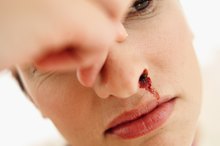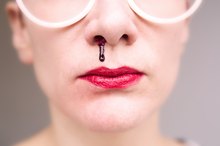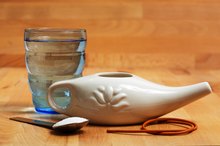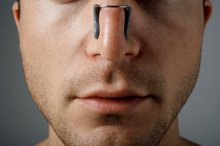How to Give the Nose Moisture Without Saline Spray
A dry nose causes itching, burning and sometimes bleeding. Although there are several causes for dry nose, there are limited remedies in combating the dryness. Saline nasal spray is one of the main ways to combat dry nose; however, if you wish to avoid using it, there are other ways to promote more moisture in your nose.
Increase Your Fluid Intake
Staying hydrated promotes regular mucus production. The current guideline is to drink at least eight 8-ounce glasses of water per day, which can include tea and juice. However, during hotter months you should drink more water than juice, since consuming too much sugar can promote dehydration. If your dry nose is caused by dehydration, you may also experience dry mouth, increased thirst, dry skin, decreased urine output, constipation or dizziness.
- Staying hydrated promotes regular mucus production.
- However, during hotter months you should drink more water than juice, since consuming too much sugar can promote dehydration.
Increase Humidity
How to Keep Your Nose From Drying on a Plane
Learn More
One way to promote mucus production in your nose is to keep the air around you humid by using a humidifier. One type of humidifier called a vaporizer promotes humidity by boiling water and releasing the steam through a vent or a hole at the top of the vaporizer. Some vaporizers also have a compartment to add liquid decongestants. Making your environment more humid can prevent your nostrils from becoming dry during months in which there is little humidity. Make sure to clean your humidifier on a regular basis, as mold and bacteria can grow inside of the machine and the mold spores may be released with the mist.
- One way to promote mucus production in your nose is to keep the air around you humid by using a humidifier.
Over-the-Counter Moisturizers
If you want to avoid using saline nasal spray, you can use over-the-counter rub-in moisturizers. These moisturizers are formulated to quickly relieve dryness in your nasal passage. If you can’t find rub-in moisturizers you can also use water-based lubricants. Place the lubricant in your nostril by squirting a small bit on a cotton swab and rubbing it inside your nostrils. Be careful not to go too far back in your nostril as this can irritate the lining and cause bleeding. If you have petroleum jelly at home, you can rub a bit of it in your nose for relief; however, using petroleum jelly in your nose for prolonged periods can cause lung problems.
- If you want to avoid using saline nasal spray, you can use over-the-counter rub-in moisturizers.
- If you have petroleum jelly at home, you can rub a bit of it in your nose for relief; however, using petroleum jelly in your nose for prolonged periods can cause lung problems.
Prescription Medications
How to Get Rid of a Scabby Nose
Learn More
Prescription medications may be used to increase moisture in your nose. Liposomal nasal spray (LipoNasal), nasal ointment with dexpanthenol (Bepanthen) and spray containing NaCL (Rhinomer) are examples of these medications 3.
Considerations
Check the side effects of any medications you are taking as some can cause dehydration or reduce mucus production. If medication is the culprit, consult your physician, who may change your prescription. If you experience a nosebleed along with nose dryness, contact your physician.
Related Articles
References
- American Academy of Otolaryngology -- Head and Neck Surgery: Fact Sheet -- Your Nose, the Guardian of Your Lungs
- European Archives of Oto-Rhino-Larngology: Tolerability and Effects on Quality of Life of Liposomal Nasal Spray Treatment Compared to Nasal Ointment Containing Dexpanthenol or Isotonic NaCl Spray in Patients with Rhinitis Sicca
- Nishimura M. High-flow nasal cannula oxygen therapy in adults. J Intensive Care. 2015;3(1):15. doi:10.1186/s40560-015-0084-5
- Callebaut I, Hox V, Bobic S, et al. Effect of nasal anti-inflammatory treatment in chronic obstructive pulmonary disease. Am J Rhinol Allergy. 2013;27(4):273-7. doi:10.2500/ajra.2013.27.3887
- Elliott MW. Non-invasive ventilation for acute respiratory disease. Br Med Bull. 2004;72:83-97. doi:10.1093/bmb/ldh042
- Nishimura M. High-Flow Nasal Cannula Oxygen Therapy In Adults. 2015. Journal of Intensive Care. doi:10.1186/s40560-015-0084-5
Writer Bio
April Khan is a medical journalist who began writing in 2005. She has contributed to publications such as "BBC Focus." In 2012, Khan received her Doctor of Public Health from the University of Medicine and Dentistry of New Jersey. She also holds an Associate of Arts from the Art Institute of Dallas and a Master of Science in international health from University College London.









